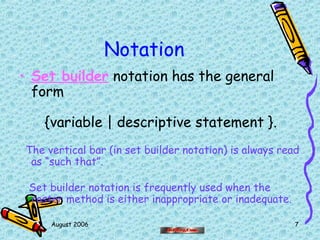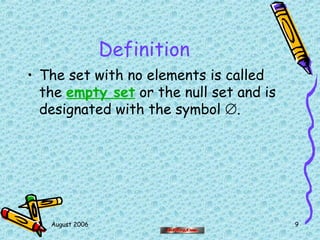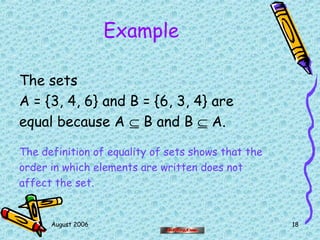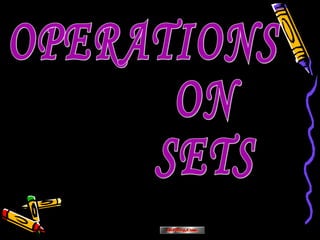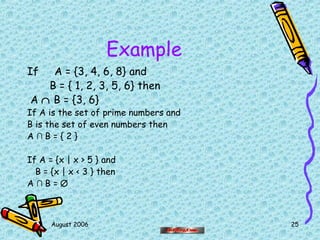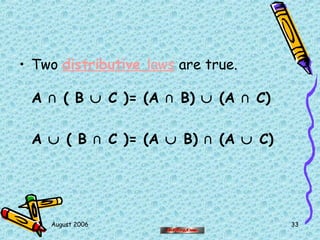Introduction to sets
- 2. August 2006 2 Definitions • A set is a collection of objects. • Objects in the collection are called elements of the set.
- 3. August 2006 3 Examples - set The collection of persons living in INDIA is a set. – Each person living in INDIA is an element of the set. The collection of all countries in the state of Texas is a set. – Each county in Texas is an element of the set.
- 4. August 2006 4 Examples - set The collection of counting numbers is a set. – Each counting number is an element of the set. The collection of pencils in your briefcase is a set. – Each pencil in your briefcase is an element of the set.
- 5. August 2006 5 Notation • Sets are usually designated with capital letters. • Elements of a set are usually designated with lower case letters.
- 6. August 2006 6 Notation • The roster method of specifying a set consists of surrounding the collection of elements with braces. For example the set of counting numbers from 1 to 5 would be written as {1, 2, 3, 4, 5}.
- 7. August 2006 7 Notation • Set builder notation has the general form {variable | descriptive statement }. The vertical bar (in set builder notation) is always read as “such that”. Set builder notation is frequently used when the roster method is either inappropriate or inadequate.
- 8. August 2006 8 Example – set builder notation {x | x < 6 and x is a counting number} is the set of all counting numbers less than 6. Note this is the same set as {1,2,3,4,5}. {x | x is a fraction whose numerator is 1 and whose denominator is a counting number }.
- 9. August 2006 9 Definition • The set with no elements is called the empty set or the null set and is designated with the symbol ∅.
- 10. August 2006 10 Examples – empty set – The set of all pencils in your briefcase might indeed be the empty set. – The set of even prime numbers greater than 2 is the empty set. – The set {x | x < 3 and x > 5} is the empty set.
- 11. August 2006 11 Definition - subset • The set A is a subset of the set B if every element of A is an element of B. • If A is a subset of B and B contains elements which are not in A, then A is a proper subset of B.
- 12. August 2006 12 Notation - subset If A is a subset of B we write A ⊆ B to designate that relationship. If A is a proper subset of B we write A ⊂ B to designate that relationship. If A is not a subset of B we write A ⊄ B to designate that relationship.
- 13. August 2006 13 Example - subset The set A = {1, 2, 3} is a subset of the set B ={1, 2, 3, 4, 5, 6} because each element of A is an element of B. We write A ⊆ B to designate this relationship between A and B. We could also write {1, 2, 3} ⊆ {1, 2, 3, 4, 5, 6}
- 14. August 2006 14 Example - subset The set A = {3, 5, 7} is not a subset of the set B = {1, 4, 5, 7, 9} because 3 is an element of A but is not an element of B. The empty set is a subset of every set, because every element of the empty set is an element of every other set.
- 15. August 2006 15 PROPER SUBSET: • If A B and A≠B then A is called a⊆ proper subset of B, written as A B.⊂ • For e.g.A={1,3,5},B={1,2,3,4,5,6}
- 16. August 2006 16 UNIVERSAL SET: • A set U is called a universal set. If all the sets under consideration are sub-sets of the set U. • For e.g. If A {1,2,3,4},B {2,3,5,7} and C={2,4,6,8}then the universal set U={1,2,3,4,5,6,7,8,9}. POWER SET: • The collection of all possible subsets of a given set A is the power set of A. It is denoted by P(A). • For e.g. If A={1,2,3} then • P(A)={Ø,{1},{2},{3},{1,2},{2,3},{1,3}, {1,2,3}}.
- 17. August 2006 17 EQUAL SETS • Two sets A and B are equal if A ⊆ B and B ⊆ A. If two sets A and B are equal we write A = B to designate that relationship.
- 18. August 2006 18 Example The sets A = {3, 4, 6} and B = {6, 3, 4} are equal because A ⊆ B and B ⊆ A. The definition of equality of sets shows that the order in which elements are written does not affect the set.
- 19. August 2006 19 Example If A = {1, 2, 3, 4, 5} and B = {x | x < 6 and x is a counting number} then A is a subset of B because every element of A is an element of B and B is a subset of A because every element of B is an element of A. Therefore the two sets are equal and we write A = B.
- 20. August 2006 20
- 21. August 2006 21 Definition - union • The union of two sets A and B is the set containing those elements which are elements of A or elements of B. We write A ∪ B If A = {3, 4, 6} and B = { 1, 2, 3, 5, 6} then A ∪ B = {1, 2, 3, 4, 5, 6}.
- 22. August 2006 22 Example - Union If A is the set of prime numbers and B is the set of even numbers then A ∪ B = {x | x is even or x is prime }. If A = {x | x > 5 } and B = {x | x < 3 } then A ∪ B = {x | x < 3 or x > 5 }.
- 23. August 2006 23 Venn Diagram - union A is represented by the red circle and B is represented by the blue circle. The purple colored region illustrates the intersection. The union consists of all points which are colored red or blue or purple. A ∪ B A∩B
- 24. August 2006 24 Definition - intersection • The intersection of two sets A and B is the set containing those elements which are elements of A and elements of B. We write A ∩ B
- 25. August 2006 25 Example If A = {3, 4, 6, 8} and B = { 1, 2, 3, 5, 6} then A ∩ B = {3, 6} If A is the set of prime numbers and B is the set of even numbers then A ∩ B = { 2 } If A = {x | x > 5 } and B = {x | x < 3 } then A ∩ B = ∅
- 26. August 2006 26 Example If A = {x | x < 4 } and B = {x | x >1 } then A ∩ B = {x | 1 < x < 4 } If A = {x | x > 4 } and B = {x | x >7 } then A ∩ B = {x | x < 7 }
- 27. August 2006 27 These sets can be visualized with circles in what is called a Venn Diagram. A B A ∩ B Everything that is in A AND B.
- 28. August 2006 28 • Disjoint sets:Two sets A and B are disjoint sets, if A B=Ø.For e.g.∩ If A={2,4,6,8} and B={ 1,3,5,7} then A and B are disjoint sets. Note: If A B ≠Ø, then A and B are said to∩ be intersecting sets or overlapping sets. • Difference of sets: If A and B are two sets, then their difference A-B is the set containing exactly those element in A that are not in B. Eg:- A={a,b,c} B={a,d} A-B={b,c}
- 29. August 2006 29 • Symmetric difference:-Symmetric difference of two sets P&Q is the set containing exactly all the elements that are not in P or in Q but not in both. P(+)Q=(PUQ)-(P Q∩ ) Eg:-P={a,b} Q={a,c} Then symmetric difference is {b,c}
- 30. August 2006 30
- 31. August 2006 31 • Union and intersection are commutative operations. A ∪ B = B ∪ A A B = B A∩ ∩ • Union and intersection are associative operations. (A ∪ B) ∪ C = A ∪ (B ∪ C) (A B) C = B (A C)∩ ∩ ∩ ∩
- 32. August 2006 32 • Idempotent law:- AUA=A A A=A∩ • Identity law:- AU∅=A AUU=U A U=A∩ • Complement law:- AUA’=U U’= ∅
- 33. August 2006 33 • Two distributive laws are true. A (∩ B ∪ C )= (A ∩ B) ∪ (A ∩ C) A ∪ ( B ∩ C )= (A ∪ B) ∩ (A ∪ C)






